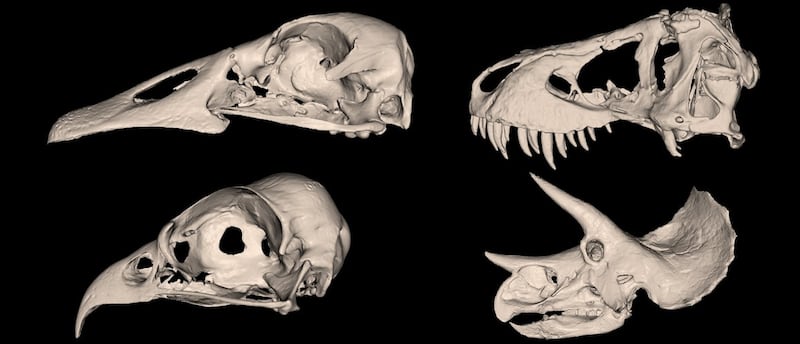Bird skulls evolved much more slowly and are far less diverse than those of dinosaurs, a new study suggests.
The birds’ skulls may be more limited in their ability to adapt and specialise than their dinosaur cousins due to the evolution of a big brain, researchers say.
The study of more than 390 birds and dinosaurs includes 3D data from the Natural History Museum’s famous Dippy the Diplodocus and Sophie the Stegosaurus specimens.
Scientists at the Natural History Museum, led by Dr Ryan Felice, scientific associate, and Prof Anjali Goswami, research leader, found that the diversity in birds’ skulls today actually represents a huge bottleneck and evolutionary slowdown compared to other dinosaurs.
While the earliest birds evolved 150 million years ago, in the Jurassic, previous studies suggest their modern diversity evolved in a burst of evolution after the other dinosaurs died out in the end -Cretaceous mass extinction.
However, researchers say diversity is only the tip of the iceberg of broader variation in dinosaurs, the precursor to modern birds.

Dr Felice said: “One of the biggest differences between birds and non-avian dinosaurs is the top of the skull or braincase.
“This part of the skull evolves into lots of different forms across non–avian dinosaur species and at very fast rates.
“The same part of the skull, however, is constrained in birds.
“This seems to be because dinosaurs have lots of variation in this region, associated with cranial ornaments, such as in the Triceratops.
“In contrast very few birds have bony ornaments like horns and crests on the skull.”
The team studied the structure of the bird and dinosaur skulls, using high resolution 3D scanning to explore how the bird skull fits into the big picture of dinosaur skull evolution.
The skulls of more than 390 species of birds and non-avian dinosaurs were 3D surface and CT scanned to create the biggest dataset of bird and dinosaur skulls to date.
Studies were carried out to identify hundreds of 3D points of comparison across all these species.
This made it possible to reconstruct the evolution of their skulls over more than 200 million years.
Researchers say that no study to date has ever captured such a huge range of dinosaur diversity in such detail or directly compared the shape of the skull across the full range of living and extinct dinosaurs.
The team was surprised to find that their results indicate the skull evolves much slower in birds than in non-avian dinosaurs.
In birds most of the skull is taken up by large eyes and brains, rather than large biting muscles or ornaments.
As a result, bird skulls are variable in the beak but not in the top or back of the skull, researchers say.
Birds elaborate their heads with feathers instead of bony elements.
Prof Goswami added: “By being able to directly compare birds with other dinosaurs, we can see that there wasn’t an explosion of bird skull shape after dinosaurs went extinct.
“Rather, skull evolution seemed to hit the brake pedal when birds evolved, with much, much slower evolution in birds than in other kinds of dinosaurs.
“Birds are the only dinosaurs alive today, but they are nowhere near as diverse or fast evolving as other dinosaurs were before the mass extinction.
“Dinosaurs evolved much faster before they became birds.
“In fact, some of the specialised features of birds, like their big brains and eyes, might limit how their skulls evolve and be the main reason they can’t evolve as much variation as their extinct relatives.”
The study, Decelerated dinosaur skull evolution with the origin of birds, is published in the journal PLoS Biology.







